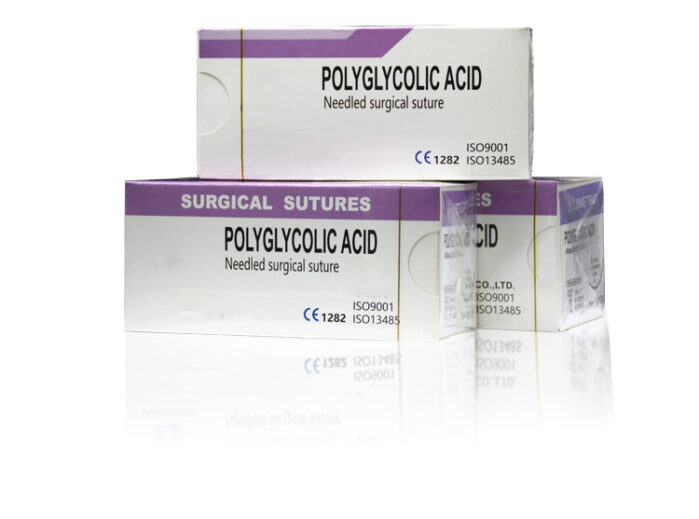Surgical suture threads: Generally, they can be divided into two categories: absorbable threads and non-absorbable threads.
Absorbable suture threads are divided into: sheep intestine thread, chemically synthesized thread (PGA), and natural collagen suture threads, depending on the material and degree of absorption.
- Sheep intestinal thread: made from the intestines of healthy animals, sheep and goats, containing collagen, so there is no need to remove the thread after suturing. Medical intestinal threads are divided into two types: ordinary intestinal threads and chromium intestinal threads, both of which can be absorbed. The length of time required for absorption depends on the thickness of the intestinal thread and the condition of the tissue, and is generally absorbed in 6 to 20 days, but individual patient differences affect the absorption process, or even non-absorption. The intestinal threads are packed in disposable sterile packaging, which is convenient to use.
- Common intestinal thread: easily absorbed suture made from the submucosa of sheep intestine or bovine intestine. It is absorbed quickly, but the tissue reaction to the intestinal thread is slightly greater. It is mostly used for faster healing tissues or subcutaneous tissues for ligating blood vessels and suturing infected wounds, etc. It is generally used in the mucosal layer of the uterus and bladder.
- Chromium intestinal thread: This intestinal thread is made of chromic acid treatment, which slows down the absorption rate of tissues and causes less inflammation than ordinary intestinal thread. It is often used in gynecological and urological surgeries, and is the suture of choice for kidney and ureteral surgeries, as silk thread can promote the formation of stones. When used, it is soaked in salt water and straightened after being softened to facilitate surgical operations.
- Chemical synthetic thread (PGA, PGLA, PLA): a polymer thread material made by present chemical technology, made by the process of thread extraction and coating, etc. It is generally absorbed within 60-90 days and absorbed stably. If the production process is the reason, there are other non-degradable chemical components, the absorption is incomplete.
- Pure natural collagen suture: taken from the special animal otter tendon parts, high content of pure natural collagen, production process without the involvement of chemical components, with the characteristics of collagen should have; for the true sense of the fourth generation of sutures. It has complete absorption, high tensile strength, good biocompatibility, promotes cell growth, etc. Depending on the thickness of the thread, it is usually absorbed completely in 8-15 days, and the absorption is stable and reliable with no significant individual differences. Non-absorbable threads are sutures that cannot be absorbed by tissues, so they need to be removed after suturing. The specific time of suture removal varies depending on the site of the suture and the wound and the patient’s condition. When the wound heals well without infection and other abnormalities: 4-5 days for the face and neck; 6-7 days for the lower abdomen and perineum; 7-9 days for the chest, upper abdomen, back and buttocks; 10-12 days for the extremities, with some extension for the near joints, and 14 days for the hypotonic suture. In special cases such as malnutrition and large tension in the incision, the stitch removal time can be extended appropriately. Adolescents can shorten the time of suture removal, while the elderly, diabetic patients and those with chronic diseases can delay the time of suture removal. If the wound is obviously infected with redness, swelling, heat and pain after surgery, the stitches should be removed earlier.
In case of the following conditions, the removal of stitches should be delayed.
- Severe anemia, wasting, and mild cachexia.
- Severe water loss or water-electrolyte disorders that have not been corrected.
- Elderly patients and infants.
- When the cough is not controlled, the removal of stitches should be delayed for thoracic and abdominal incisions.








